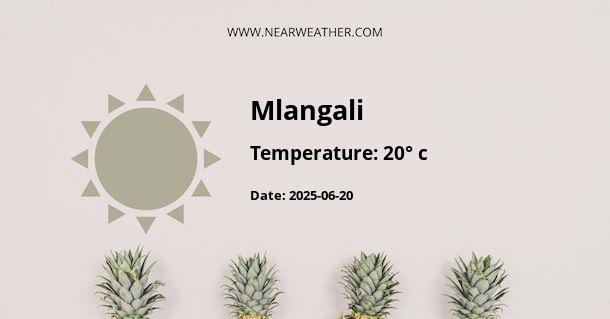Overview of Mlangali, Tanzania
Mlangali is a charming locale in the southeastern part of Tanzania. Located in the Njombe Region, this area is known for its moderate climate, stunning natural beauty, and rich cultural heritage. The region's weather is primarily influenced by its geographical features, including its elevation and proximity to the Indian Ocean.
Climate and Weather in Mlangali, Tanzania
The climate in Mlangali is classified as tropical. The region experiences a significant amount of rainfall throughout the year, even during the driest months. This type of climate is commonly referred to as an 'Am' climate in the Köppen and Geiger climate classification.
Temperature
The average annual temperature in Mlangali is approximately 20.4°C. The warmest month of the year is February, with an average temperature of 21.7°C. The coolest month is July, with an average temperature of 18.7°C.
Rainfall
Rainfall is a significant factor in Mlangali's climate. The region receives an average annual precipitation of about 1004 mm. The wettest month is March, receiving an average of 153 mm of rainfall, while the driest month is July with an average of 2 mm.
Seasonal Weather Patterns
Mlangali's weather patterns are influenced by the Indian Ocean monsoon winds, resulting in two distinct seasons: the wet season and the dry season.
The Wet Season
The wet season in Mlangali typically runs from November through April. During this time, the region experiences high humidity and heavy rainfall, particularly from March to May. This period is often referred to as the "long rains" season. The temperatures during this period range from 20°C to 30°C.
The Dry Season
The dry season in Mlangali spans from May to October. Despite being labeled as the 'dry' season, the region still experiences some rainfall, albeit much less compared to the wet season. July is the driest month. Temperatures during this period range from 18°C to 28°C.
Impact of Climate on Lifestyle and Agriculture
The climate in Mlangali significantly impacts the lifestyle of its residents and the region's agriculture. Agriculture is a significant part of life in Mlangali, with the majority of the population relying on it for their livelihood.
"The region's climate, particularly the predictable rainfall patterns, favors the cultivation of a variety of crops, including maize, beans, bananas, and various types of vegetables."
However, the wet season's heavy rains can sometimes result in flooding, posing challenges to farming activities. On the other hand, the relatively cooler temperatures during the dry season provide ideal conditions for growing certain types of crops.
Climate Change and Its Effects
Like many regions worldwide, Mlangali is facing the impacts of climate change. Changes in temperature and precipitation patterns pose significant risks to the region's agricultural sector.
"Evidence of climate change in the area includes increased temperatures, unpredictable rainfall patterns, and extreme weather events such as floods and droughts."
These changes have the potential to affect crop yields, disrupt farming schedules, and increase susceptibility to pests and diseases.
Conclusion
In conclusion, Mlangali, Tanzania offers a unique climate characterized by a combination of tropical temperatures and significant rainfall. While this climate presents certain challenges, it also provides opportunities for diverse agricultural activities. However, the looming threat of climate change necessitates adaptive strategies to safeguard the region's agriculture and sustain the livelihoods of its inhabitants.
A - Mlangali's Latitude is -9.783330 & Longitude is 34.516670.
A - Weather in Mlangali is 15° today.
A - Climate Conditions in Mlangali shows scattered clouds today.
A - Humidity in Mlangali is 82% today.
A - Wind speed in Mlangali is 10.84 km/h, flowing at 63° wind direction. today.
